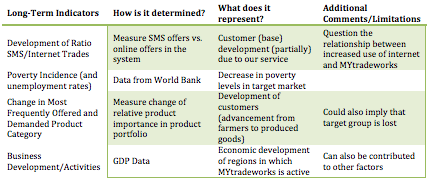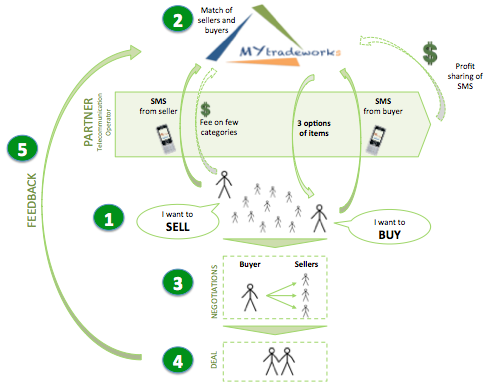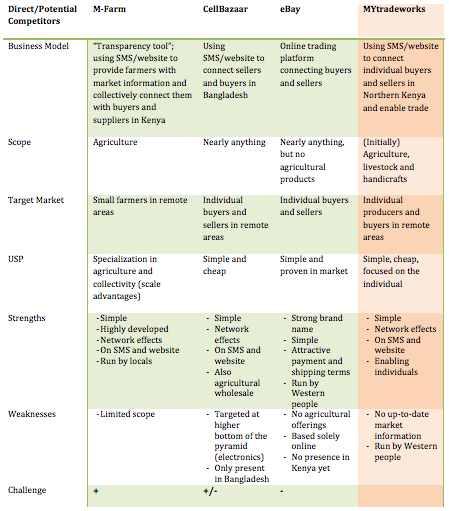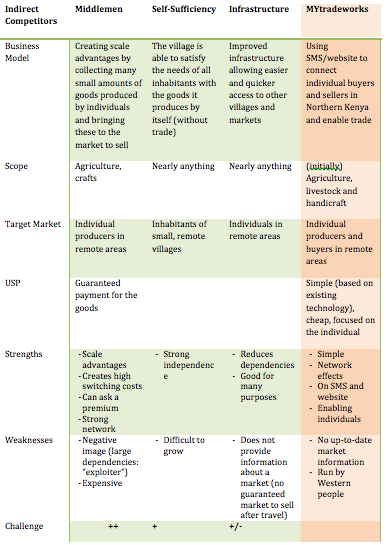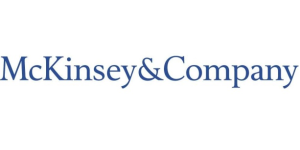MyTradeworks
Overview
Category: Trade and Market Access
Event: Global Social Business Competition 2013
Rank: Winner
Team: Gabrielle Snijder, Manuela Hug, Estee Hak, Nadege Ruzicka
Project Status

Out of the 7 billion people on our planet, 1.4 billion still live in extreme poverty, meaning they have to survive on less than US$1.25 a day. Worldwide, 70% of those extreme poor live in rural areas (World Bank, 2012) – most of them in developing countries. Given the forecasts of a 50% increase in the population by 2050 (IFAD, 2011), of which the majority will be in developing countries, the fight against rural poverty can no longer be postponed. Poverty in rural areas has several causes. One of the most prevalent causes is the lack of infrastructure. Without proper transport and access to information systems like the Internet, markets cannot work well and thus business opportunities and subsequent jobs at the bottom of the pyramid are limited.
Imagine a farmer producing a good that he (or she) would like to sell. Due to the large distance to the market he not only has to solve the challenge of transportation but he also does not know if he can find a buyer or what price he can ask for his goods. To overcome his problem, he relies on a “middleman” who buys the goods from the farmer and resells it with a profit margin. This significantly reduces the potential profit for the farmer and also makes him dependent on the middleman. In a nutshell, the basic mechanism of efficient markets – the free exchange of goods and services – cannot work efficiently in rural areas as most of the people neither have direct market access nor transparent information. Without these efficient market structures, people are not only unable to fulfil their basic needs but also have no incentives to produce more if they believe they will not sell it. Under these conditions, businesses cannot advance and subsequent job creation is hindered. Without economic development, investments in improving infrastructure and living standards cannot be realized. Hence, finding a solution to improve this market situation is key in order to fight rural poverty and improve future perspectives for its people.
Limited access to infrastructure like Internet or efficient transportation prevents improvements in the way business is conducted and subsequently in the standards of living for rural people. Rather than building roads or installing broadband access which takes decades before benefits can be reaped by those in need, the immense infrastructural hurdles are bypassed by working with what the people already know and use; mobile phones. As a matter of fact, according to CNN (2012) more people in
Africa have access to a mobile phone than to electricity, with a mobile phone penetration rate close to 80% (Business Wire, 2012). Tapping into the unrealized potential of this widespread technology allows the efficient connection of people and their environment.
For this purpose, a platform that matches supply and demand through mobile phones in rural areas will be introduced. The goal is to create a transparent market that connects people through the direct trading of goods and services and build a strong network among the rural communities. This service allows direct market access and can replace the “middlemen”, resulting in a more efficient distribution of resources, which in turn enables economic development in rural areas.
From the user’s perspective, the mobile platform includes the following steps:
1. The user sends an SMS to the platform indicating the item he/she wishes to buy or sell, including information like price range and location.
2. The platform’s software processes the information and matches buyer and seller. In case there is no match, an SMS is sent to inform the user he/she will be contacted when a match is found.
3. In case of a match, the buyer receives an SMS with the three most relevant offers to his/her demand. The buyer also receives the phone numbers of the potential sellers in order to negotiate with them and close the deal.
4. The buyer and seller meet at a place and time that is convenient for both.
Once MYtradeworks has reached a critical user mass, a full marketplace and a network of traders will develop in the rural areas, resulting in efficient market conditions. This enables people to specialize, reach economies of scale, create businesses and jobs and finally improve their future perspectives.
MYtradeworks will improve the standard of living for individuals in remote rural areas by empowering those at the BoP to engage in more trade. This will spur economic development in those regions. MYtradeworks will connect buyers and sellers directly, allowing them to buy and sell goods at efficient market prices and therewith providing them with more capital to invest in their production. This allows them to grow their businesses, become more specialized and eventually increase their living standards. The individual producers can bypass the middlemen who currently form their only link to the market.
As producers grow their businesses, (additional) jobs for individuals at the BoP will be created. Two different groups of producers are addressed: those who are currently self-sustaining with the desire to turn their activities into a business and those that have a business and want to expand their production. This creates jobs at two levels: at the individual level in the form of for example new farmers and secondly at the level of the community in the form of additional personnel needed to run the expanded business.
MYtradeworks’ social impact can be deemed even more important when taking into account the scalability of the business model. In essence, the business model has the potential to be implemented in all poor, rural areas in Africa, Asia and South America. This means that there is a potential reach of 1.3 billion people (Ifad, 2011) who could benefit from this solution.
In order to measure the social impact of MYtradeworks. Several key performance indicators will be used to measure short-term social impact, and other measures will be used to determine the long-term impact.
MYtradeworks business model: low-cost, high-volume network.
The MYtradeworks business model is based on:
1. Enabling a low-cost connection between sellers and buyers in remote, rural areas via existing SMS technology
2. Relying on a large volume of SMSs sent over the network for revenues by charging a premium fee for the SMS
By allowing the sellers to connect with buyers at a minimal price, the benefit (revenue) of being able to sell perishable or excess goods will always be greater than the cost of finding a buyer. Likewise, the buyers’ risk of losing time and money by travelling to a market without information about the goods traded there is reduced significantly. Thus, relative distance is decreased and new markets are created.
Within this model, sellers and buyers are provided with a simple and non-costly way of finding each other via their mobile phone. As sellers do not have to give half their profit margin to the middleman, it is expected that they would be willing to pay the premium for the SMS.
After the initial investment in the MYtradeworks hardware and software systems has been returned, the revenue can be used to maintain and further develop the system. Eventually, an Internet platform that provides a stronger interface for MYtradeworks can be set up. In the long-run there is room for several business extensions such as a transportation service and information provision.
The MYtradeworks business model is not restricted to a single product category, which makes it appealing for a broad range of customers. The value of the network is enhanced with every new user, so there is a great scale potential to be exploited. As the model is not specific to Kenya, since partners can feasibly be found in other similar countries, it is replicable across borders.
The main demographic characteristics of our customers include low-income (up to $2.50day) and living in rural, remote areas, e.g. farmers, herders, craftsmen, skilled and semi-skilled workers. Furthermore, the target group has mobile phone access. Kenya is a very suitable geographical target for our service, due to its widespread mobile phone penetration (77% – Communications Commission of Kenya, 2012), and relatively low Internet penetration (28% – Internet World Stats, 2012): a context in which the focus on mobile technology makes most sense. During the start-up phase, MYtradeworks will focus on North Kenya, where the poorest communities of Kenya are found. The sparsely populated and arid zones create a difficult environment for its inhabitants, and the lack of infrastructure and long distances between villages increase the need for improved market mechanisms. MYtradeworks will offer the inhabitants several benefits:
Increased efficiency and saved time for buyer/seller: a higher success rate of travelling to the marketplace, as people gain knowledge on potential demand/supply of products before heading to a local market and they have the possibility of arranging exchanges without the physical market.
Knowledge on production and availability: improved management and a reduction in waste and losses of perishable goods.
Decreased information asymmetry: knowledge of offers for similar goods allows buyers/sellers to make optimal, informed decisions based on price transparency. Moreover, as the user base increases, prices will converge to market prices.
Independence from the “middleman”: the platform reduces the need of the “middleman” as it directly connects buyers and sellers, and increased transparency reduces potential exploitation.
Meeting new people and exchanging ideas: can enhance a community feeling. A connected and informed network empowers people to collaborate and improve their future perspectives.
Direct access to a larger marketplace: the potential customer base is no longer limited to local people. The total amount of business activities increases which sets the basis for higher incomes.
MYtradeworks provides direct market access to poor individuals in remote, rural areas. It establishes direct contact between potential buyers and sellers, which reduces transaction costs, as less time and money, is wasted to search for potential trading partners. In this manner, any travels to the marketplace become more effective as chances for successful trades are higher. Furthermore, MYtradeworks eliminates the middleman’s profit margin, therewith increasing the sellers’ profits and lowering the buyers’ prices.
MYtradeworks is significantly different from other players in the market as it connects people at the BoP in rural areas to empower them to trade independently and provides them with market information. Individual producers are addressed, not only large bulk producers. It is therefore possible for individuals to trade on a small scale and for personal use only. Furthermore, in line with the concept of network externalities, the larger the user mass grows, the more beneficial MYtradeworks becomes for the individual user as market transparency increases. In addition, MYtradeworks contributes to the development of a network of traders in specific regions, which strengthens the community feeling. Being part of a strong network of people in similar situations and experiencing many different business activities in one’s environment can contribute to a more positive future outlook of individuals.
When examining the competitive environment in which MYtradeworks will operate, we can identify direct (similar target market, similar solution), potential (different target market) and indirect competitors (substitutes). As MYtradeworks will enter a new market, very few direct competitors exist and therefore potential and indirect competitors are of higher relevance. We have combined the direct and potential competitors in our analysis to find the following firms:
M-Farm is a mobile and web start-up which uses a basic SMS-interface to help farmers by providing access to current market prices, aggregating their needs to get favourable prices from suppliers, and giving them direct, collective access to both regional and export markets for their products. (kimoquaintance.com, 2013)
CellBazaar is a mobile-based electronic marketplace in Bangladesh. The service allows individuals to buy and sell any type of goods (mainly electronics) in his region in a simple way using mobile phone or Internet. The company targets high-end BoP customers. (cellbazaar.com, 2013)
eBay is the largest online (US-based) marketplace with an enormous global reach. A community of private customers -and some small companies- can access the service via any connected electronic device to buy and sell anything they like. (ebay.com, 2013)
Of these competitors, only M-Farm is active in the Kenyan market. Nevertheless, all competitors have strengths and weaknesses in their similarities and differences with MYtradeworks. The following table provides an overview of these differences and consequently the degree to which the competitors form a challenge for MYtradeworks.
The indirect competitors are more important in this case as they are alternatives to the MYtradeworks solution since the exact same solution does not yet exist. The table below describes how middlemen, self-sufficiency of villages and improved infrastructure can be substitutes and can therefore form a challenge to MYtradeworks.
In short, challenges can be found in MYtradeworks’ competitive environment. However, we do not deem these challenges insurmountable as we clearly see the distinction in MYtradeworks’ value proposition.
The SWOT analysis is based on the launch of the MYtradeworks solution in Kenya.
Strengths
- Low capital requirement due to the straightforward technological nature of the MYtradeworks platform, and similar technology existing in the market.
- The MYtradeworks solution is very scalable and can be expanded into many different countries facing similar conditions.
- When Internet penetration increases, the online platform can complement the SMS service, further extending the reach of the solution.
- High social impact.
Weaknesses
- Dependence on supplier is high during the time in which the technology used is SMS rather than the Internet. To prevent the partner from obtaining a high bargaining power, a partnership will be formed.
- Need for a critical user mass in order to have a wide product offering and thus meet demand and satisfy sellers.
- Difficult to access market knowledge.
Opportunities
- Large market with a need for trade.
- High mobile phone penetration (72%).
- Technologically advanced country with individuals that have a strong affinity with mobile technology and are used to using their mobile phones for more than calls and SMSes, using mobile phones for mobile payment services such as M-Pesa.
- First-mover advantage which leads to the possibility of generating the required critical user mass.
- Low entry barriers.
Threats
- Perceived switching costs from the convenience of the middleman.
- Potential of new substitutes such as new technologies and development of infrastructure such as roads.
- Volatile political environment can have a significant influence on conducting business in the country.
- Health risks which can prevent individuals from growing their businesses.
- Natural resource related risks in the sense that if the soil becomes too arid and limits the production of goods on the soil, there will be fewer products to be traded.

